
scrounge: /skrounj/ informal verb: to actively seek [books] from any available source
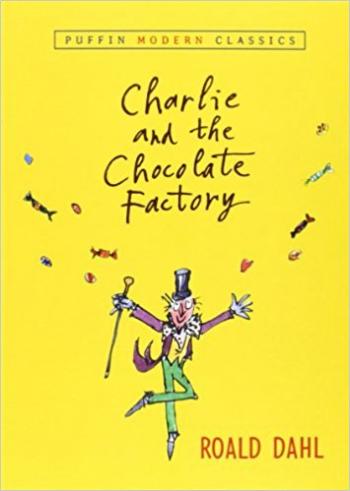
Charlie and the Chocolate Factory is the first Roald Dahl book that I've ever read. I'm ashamed to say I made it to adulthood before I even realized that his first name wasn't actually "Ronald." But it's better late than never, isn't it?
I'll also admit that, having seen Willy Wonka's Chocolate Factory as a child, it is difficult to mentally separate this story from Gene Wilder's magical portrayal of Wonka (I've heard some say that Depp was closer to the book, personality-wise, but I didn't see that version).
All the same, the song "Pure Imagination" captures this story quite aptly. What child has not fantasized about everlasting candy? This made "the chocolate room" all the more magical to me, as I absolutely used to fantasize about a natural world in which everything was made of different kinds of sweets. That as well as the boat on the chocolate river, and the great glass elevator, were the most memorable parts for me.
One aspect that I found interesting was the different treatment of Charlie in the movie vs. the book. In this book, Charlie is completely good and his fellow golden-ticket-holders are completely bad. There is no question of who the hero is because it's spelled out clearly from the beginning. Whereas, the movie apparently attempted to humanize Charlie by having him do a bad thing too.
I think that's why one thing that struck me about the book was how moralizing it came across, even underneath all the absurdity (at times reminding me of Hilaire Belloc's "cautionary" tales, minus the death of course). I have no problem with "good vs. evil" narratives; I suppose this just stands out more because I've become used to narratives that are more likely to portray complex heroes and villains. But I think the fantasy elements of the story made the fairly one-dimensional characters less problematic.
On another note, I am certain that J.K. Rowling must have been influenced by this story. Not only is there a "Slugworth" (minor character) here, but some of the goofier candy inventions remind me quite a bit of Weasleys' Wizard Wheezes.
Scrounged From: PaperbackSwap.com
Format: Paperback
Author: Roald Dahl
Illustrator: Quentin Blake
Pages: 155
Content Advisory: Some perilous and sad situations.
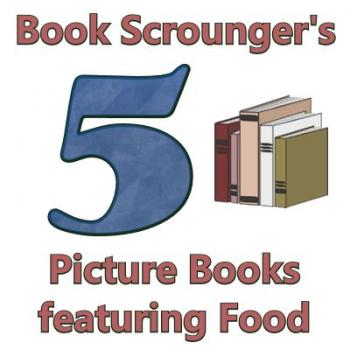
Food is a relatable topic that we often encounter in picture books -- sometimes it's viewed practically, other times in a silly way, or both. There are plenty more that could be included here, but these are some of our favorites:
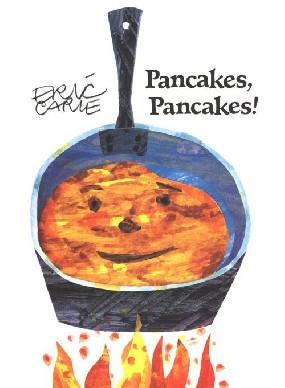
Pancakes Pancakes! is an Eric Carle book I didn't encounter until I was an adult, but I enjoyed it and the kids did too. It takes a fairly "practical" look at how pancakes are made. If you can suspend enough disbelief to allow that a boy named Jack and his mother just happened to be out of every single pancake ingredient, then it makes sense that before he can have pancakes for breakfast, Jack must take wheat to the mill to be ground into flour, milk the cow, churn some butter, fetch an egg, etc. Once he collects everything, his mother walks him through the process of combining the ingredients and cooking his first pancake. It usually succeeds in making me feel hungry by the end!
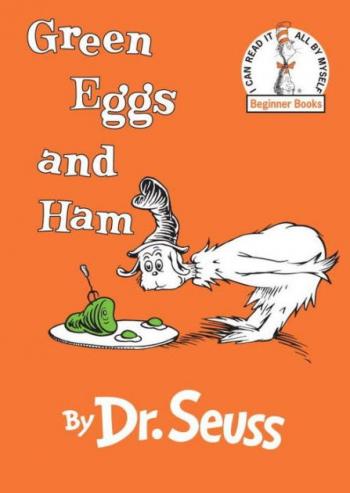
I'll admit, Green Eggs and Ham is not one of my favorite Dr. Seuss books, but it's a classic, and I'm pretty sure all the kids I've read it to have enjoyed it. Perhaps the repetition has gotten to me over the years. But I can appreciate that it encourages kids to try something before outrightly declaring that they do not like it. Either that or it encourages pestering someone to the point of insanity if they won't do what you want them to do -- decide for yourself.
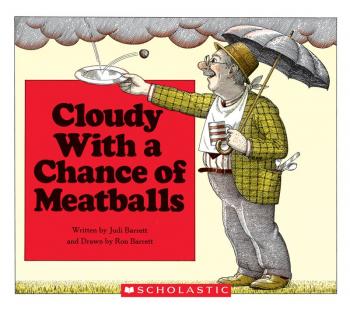
Cloudy with a Chance of Meatballs, by Judi Barrett and Ronald Barrett, is one of my favorite "tall tale" picture books ever. It's the legend of a town called Chewandswallow, where food falls from the sky. This allows for endless possibilities of weird weather, and also some interesting problems and other effects that would go along with this kind of phenomenon. Eventually, the food-weather gets weirder and larger, making life unsustainable for the brave inhabitants, and they are forced to flee. This is the best kind of picture book because the general idea can spur your creativity long after reading it -- what other kinds of food can we imagine falling from the sky? And what kinds of possibilities and problems would that lead to?
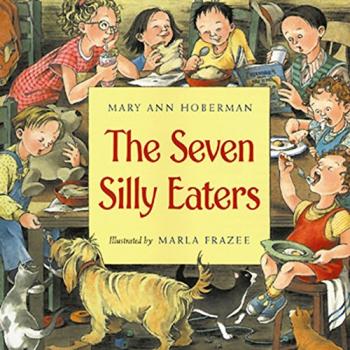
The Seven Silly Eaters is a clever story written in polished rhyme by Mary Ann Hoberman, which tells the story of a growing family of picky eaters -- each child has one particular food that they have to eat in a certain way in order to be happy. Fortunately, it's silly enough that it's easy to overlook real-world consequences of such things and to enjoy the way that the family and story both grow -- until finally, when their long-suffering mother is worn to the bone, the children accidentally invent a dish that makes life a whole lot easier for all of them. Full review here.
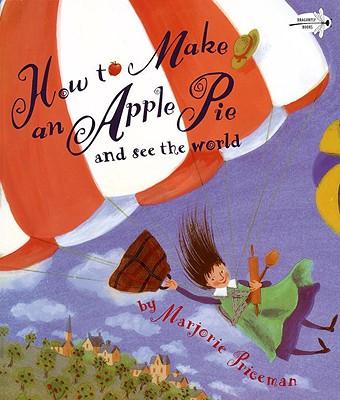
How to Make an Apple Pie and See the World takes a similar approach to Pancakes Pancakes! above, in the sense that all ingredients for the dish in question must be acquired from their sources, but this time it's done in a much more fantastical way. This book is written from a second-person point of view, which is fairly rare (the only other in this style that comes to mind at the moment is How to Dig a Hole to the Other Side of the World which is more educational but a bit fantastical too). In this book, you are instructed to go to the market to get ingredients for your pie, but if the market is closed, then you must jet off to Sri Lanka (to get cinnamon from the bark of a kurundu tree), England, Italy, Vermont, etc. to find only the best ingredients to make into an apple pie. It's a fun read, and at the very end there is a recipe to make your own apple pie.

Well, after my last picture book post (about Seven Spools of Thread) this makes back-to-back posts about picture books featuring seven siblings! Odd, considering I grew up as the oldest of seven children. Given that fact, I'm amazed I hadn't encountered Mary Ann Hoberman's The Seven Silly Eaters until just a few days ago.
This story is not only sweet and silly, but it's written entirely in rhyme -- and well-written rhyme with a consistent meter and without a bunch of awkward/forced phrasing, which makes it even better. The verses chronicle the growth of the Peters family -- from one to seven children, as their mother, Mrs. Peters (who is FAR more of a saint than I am) patiently prepares more and more special foods as the family grows, since each picky eater has only one particular food that they eat (this is the silly part, because obviously no one could survive on any of those foods alone -- pink lemonade, applesauce, milk, etc. -- and I also don't think this book is suggesting that anyone should go to these kinds of lengths to indulge picky eating).
Finally, she is so worn out that she goes to bed, wondering if anyone remembers that it's her birthday the next day. Her children do, and take it upon themselves to bake something, but their attempts -- which will surely strike terror into the heart of any neat freak (or any parent, for that matter) -- seem to be futile, especially when all their foods get combined.
The ending is so cute, and I especially like the detail in the illustrations that shows Mrs. Peters practicing her cello -- the more kids she has, the less she does it, but once the children all begin learning to help out in the kitchen, we see her doing it again. I thought this story was a great combination of reality and absurdity, and certainly portrays moments that would be familiar to anyone who grew up in (or parents/parented) a large family.
After reading this, I wondered whether anyone had actually come up with a recipe to fit this story. Well, this is the internet, so of course they did: here's one blog which took the recipe right from the author's website. We haven't tried it yet, but it looks like fun and I bet the kids will especially like making something they've already read about in a book.
Scrounged From: Our local library
Format: Paperback
Author: Mary Ann Hoberman
Illustrator: Marla Frazee
Pages: 38
Content Advisory: None
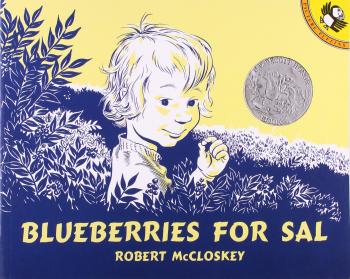
This classic has been on my bookshelves for as long as I can remember, and is not only a wonderful children's story but a celebration of one aspect of the wild beauty of my home state of Maine. While Blueberries for Sal never comes out and gives a location (aside from "Blueberry Hill"), it's not difficult to imagine that this story is based in Maine (like several of McCloskey's others), given that Maine is pretty much the world capital for wild blueberries (one of the few fruit crops that's native to North America).
When I came back to this book as an adult, I could remember the gist of the narrative -- how Sal and a baby bear get mixed up, with each following the other's mother (as both mothers are quite focused on their task of finding blueberries for the winter). But what I find most endearing about this book is the way McCloskey's illustrations so perfectly capture the mannerisms of a toddler. Sal is capable of great focus on picking, but also an inability to keep more than three blueberries in her pail without eating them. Whether it's the facial expressions or the overall strap that's perpetually falling off her shoulder, Sal is the epitome of a cute and curious toddler who is satisfied by simple things.
I used this book with my son in pre-k for "B week." After reading it, we ate blueberries and "brown bears" (chocolate teddy grahams) for snack.
Scrounged From: A gift for our child
Format: Hardcover
Author/Illustrator: Robert McCloskey
Pages: 56
Content Advisory: None


